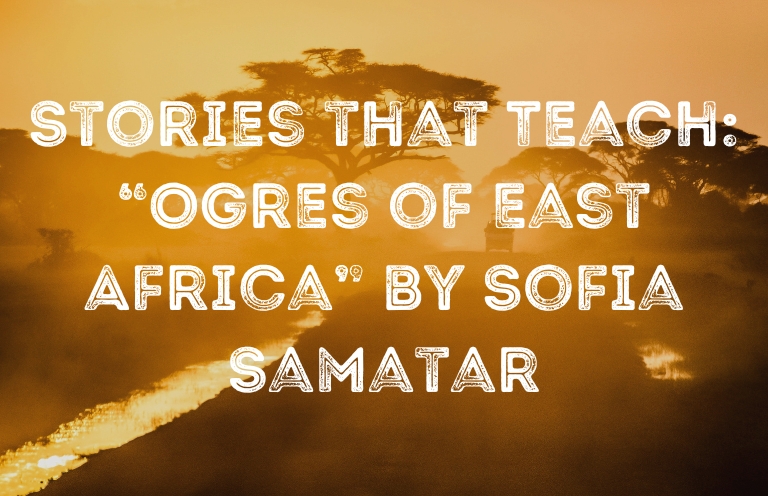When we think of teachable stories, we often reach deep into the rucksack of the literary past, pulling out classroom-tested stories that have worked their way into the canon. While there is obviously a ton to learn from these pieces, contemporary short story writers are also completing strong work built upon teachable literary foundations, while also finding fascinating ways to advance the form. In this space, we’ll highlight some of these more modern stories and explore a bit of what they have to teach us as we continue to do our part to push literature forward.

Introduction
In “Ogres of East Africa” by Sofia Samatar, (published in Uncanny), we meet Alibhai m. Moosajee. We follow Alibhai as he meets Mary, a “woman of the highlands” who becomes Alibhai’s informant in multiple ways: She tells him about the ogres, but she also presents him the option to escape from his employer. As the excursion gets underway, Mary offers Alibhai red necklaces, to give to members of the excursion as he sees fit, which will allow them to survive and interact with the ogres. The decision point of the story, such as it is, occurs with the giving of the necklaces as the group prepares to depart: Alibhai considers escape and also his own place in the world. He could leave, go back to Mombasa and pretend he’d done so at the behest of his employer, or he could use the red necklaces to safeguard his travel and as a result actually get to meet the ogres without fear, a thing his employer could never do. He gives out the necklaces to all the various servants, and together they move forward. And indeed, “The ogres are everywhere. Number thirteen: Alibhai M. Moosajee of Mombasa.”
The Basics
This story is divided in two: First, there is the catalogue of ogres as suggested by the title, and second there are parentheticals wherein we meet our characters and discover what is actually happening in the piece. This allows us to exist in both third-person present tense and first-person tense, respectively. The conflict of the story exists mostly off-page, for alternating reasons: First, because the employer has all the power at the beginning, and then because the employer has none of the power and is moving directly and without knowing to his doom. Far more important than the conflict, which is for the most part predetermined from the moment Mary arrives, this is a story about the stories we tell and how power manifests out of those stories.
Meta
This is a pretty straightforwardly meta story; the actual narrative is hidden within the conceit in such a way that the reader is forced to interact with the piece to follow it. You cannot simply read the narrative, you must keep in mind that you are reading notes in the margin. If you’re not thinking of the text as intentional chicken-scratch, as something coded to be kept away from the employer who is so insistent on hunting the ogres, then this story doesn’t really work at all. After all, the employer is presumably reading these dispatches, and that’s a large part of the meta joy of this story: knowing that the organization of resistance is happening directly underneath the nose of the man who thinks he controls every aspect of this excursion. And that is one large purpose of metafiction, which this story explicates nicely for those of us who are tearing apart story trying to figure out how to do the same for ourselves: you invite the reader to consider what storytelling aspects were chosen, and to explore how they affect the text in front of us.
But what I love about this piece is that the meta elements do not solely exist to make us think about narrative storytelling; they are additionally here to make us think about the overarching narrative arguments of the piece. This distinction is something that only the best metafiction manages to pull off: It pairs the fascinating complication of technique with clear narrative purpose. When we are reading these parenthetical sections, we are shown that these characters exist almost fully in two separate world, and we see these two worlds circling each other within the same document. In one world, the Alibhai is doing exactly as asked; in the other world on the margins, we are watching him resist. We are seeing the struggle for power take place in real-time, and we are seeing the ways that those with power both hold down the subjugated and also how that power dehumanizes so completely that cracks of opportunity then form. I’d point us most especially to the line: “Always read the fine print,” which Alibhai’s employer tells Alibhai very specifically; he is incapable of imagining a place where he doesn’t retain control, even when he is aware that the parenthetical text is entirely outside his grasp.
Leading the Reader
In a story where the narrative is nested like this, the author has a bit more than our traditional responsibility to lead the reader, to teach us how exactly to read the story. But of course, those responsibilities exist in every piece (a common refrain of these essays has been, I’ll remind, that the reader and writer function in conversation with one another), though it might be easier to ignore that truth in traditional narrative where the reader has historical precedents to fall back on. And that’s what makes a story like this so valuable: We are learning how to read the text as we read it.
I’ll point out a couple things: Though it may take a tiny while for the reader to understand that Mary is the true focalization of the narrative, she is introduced immediately, in the parenthetical second paragraph of the piece. The opening paragraph, which is a catalogue of one of the ogres, is both shorter than the parenthetical (already leading us to the possible understanding that it should receive less of our attention), and is written as simple factual statements. We are given no challenge or conflict in that first paragraph, and there is no real work done to ground the reader in that opening. All of that work is instead done in the parenthetical, leading the reader to a natural understanding of what matters most in the piece.
Other necessary work done in the opening to lead the reader’s attention where it needs to be: Mary is presented as a mystery, piquing our interest; the information about the ogre that she presents is given as a claim rather than straight fact as in our opening paragraph; we are told that the parentheticals are “fine print, and in the margins,” and then immediately told Alibhai’s employer is incapable of reading the fine print. In other words, all of the conflict of the story, all of the potential tension, has been given to the parenthetical. This is true on the plot level, on the character level, and even on the level of language.
The choice to number our sections is also important here, quickly teaching the readers that we’re not going back to the ogres once they’ve been introduced. This puts us into the fascinating position of being able to almost (almost) ignore those opening paragraphs of each section, or perhaps put more correctly, to understand that they exist for obfuscation, to keep the employer happy while the real work is done in other places.
With all of this set up from the beginning, then, it only takes a couple quick sections before the reader has learned how to interact with the text.
In conclusion
This story is an excellent example of how to build unique technical concepts into a piece without losing narrative cohesion, while also keeping the reader involved. Indeed, I might go so far as to say this is one of the strongest examples of metafiction I’ve seen; I hope it will help you think through your own experimental fiction, and to ask yourself what exactly those experimental techniques are doing in your story. Always, always, always, we come back to that question: How does the story itself benefit from the choices we’re making?
by Brandon Williams
